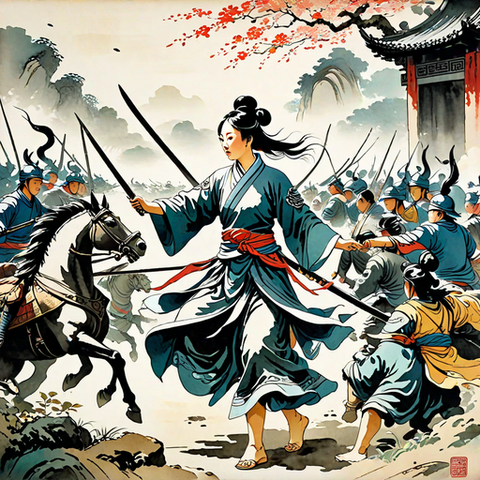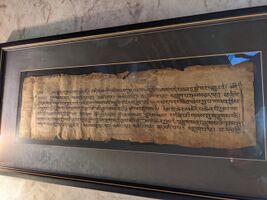The Legend of Yangchen: Difference between revisions
(created page) |
|||
| (2 intermediate revisions by the same user not shown) | |||
| Line 1: | Line 1: | ||
{{WIP}}{{Infobox|above=The Legend of Yangchen|subheader=Qanupaq: Ya Tzhanen u Yangchyen|subheader2=Yangin: Tyozh Dzhanen yu Yangchen|image=https://iiwiki.us/mediawiki/images/thumb/a/a2/8-1jPgGJvDRETSc12.png/480px-8-1jPgGJvDRETSc12.png|caption=Painting of Empress Yangchen slaughtering the invading tribe of Azunga|image2=https://iiwiki.us/mediawiki/images/thumb/c/cc/Ancient_scroll_containing_the_epic.jpg/267px-Ancient_scroll_containing_the_epic.jpg|caption2=Ancient Tibetan Scroll containing the Legend of Yangchen, written around 1500BC|title=Gesarian Legend|label1=Written:|data1=3000BC|label2=Namesake:|data2=Empress Yangchen Guul-La}} | {{WIP}}{{Infobox|above=The Legend of Yangchen|subheader=Qanupaq: Ya Tzhanen u Yangchyen|subheader2=Yangin: Tyozh Dzhanen yu Yangchen|image=https://iiwiki.us/mediawiki/images/thumb/a/a2/8-1jPgGJvDRETSc12.png/480px-8-1jPgGJvDRETSc12.png|caption=Painting of Empress Yangchen slaughtering the invading tribe of Azunga|image2=https://iiwiki.us/mediawiki/images/thumb/c/cc/Ancient_scroll_containing_the_epic.jpg/267px-Ancient_scroll_containing_the_epic.jpg|caption2=Ancient Tibetan Scroll containing the Legend of Yangchen(Chapter 1) , written around 1500BC|title=Gesarian Legend|label1=Written:|data1=3000BC|label2=Namesake:|data2=Empress Yangchen Guul-La|subheader3=Bishnut: Thayu HaAranen yi Yahn-chin|label3=Prevalent in:|data3=Gesaria, Bishnute, Yangchenia and Lilytopia.|subheader4=Lilyput-Ramesh:Thozhi TzaNevsh nyu Yayhcjin}} | ||
'''The Legend of Yangchen''' ''(Qanupaq:Ya Tzhanen u Yangchyen ; Yangin: Tyozh Dzhanen yu Yangchen)'' is a famous non-fictional Legend from the Gesaria Region and Tibet. The | '''The Legend of Yangchen''' ''(Qanupaq:Ya Tzhanen u Yangchyen ; Yangin: Tyozh Dzhanen yu Yangchen)'' is a famous non-fictional Legend from the [[Gesaria]] Region and Tibet. The legend follows the life of '''Yangchen Guul-La,''' empress of Ancient Yangchenia in 3000BC and a fearsome warrior, known for her battle prowess and merciless nature. | ||
The first half of the story discusses the early childhood of the Empress, how she was a sheltered and worshipped child of the famed '''Emperor Kaisheng and Empress Lhotse'''. After the death of the couple when Yangchen was 16, she took the throne and quickly cemented herself as the undisputed leader of the Empire. She had her enemies thrown into dungeons and tortured until they either gave up on challenging the Empress's rule or died. After the breakdown of relations and the rise of a hostile and aggressive leader, the enemy tribe of '''Azunga,''' who suddenly invaded her Kingdom and burned many villages to the ground, killing many people. Yangchen immediately called up her army and faced the Azungas in battle, where Princess Yangchen single-handedly killed 7,000 men by herself. She went on to inflict many more defeats on the Azunga with her army of 7,000 , inflicting nearly 56,000-89,000 casualties on the Azunga, which represented nearly 75% of their male population. In March of 2975BC, her army reached the Azungan capital of '''Garjin''', where she proceeded to defeat the city defenders and burn Garjin to the ground. | |||
The second half of the story discusses the aftermath of the burning of Garjin. After burning the city to the ground, the Empress had ordered all of the city's residents to be gathered up. Those who were weak and useless to her were executed, while those who were capable of labor were taken into slavery. Amidst the rubble of the city, it is said that the Empress found a young girl who was an orphan, no more than 8 years old. The Empress, being touched by the child's supposed kindness to her, adopted her and made the child her heir. | |||
The legend was passed on from generation to generation for over four thousand years, but over time, more and more of the story was lost. By 1800, only the climax of the story was still known until in 1980, a Yangchenian Scholar named Dorjee Gyalzen uncovered an ancient scroll containing the full version of the legend, and managed to publish the full version of the legend in 1990. Today, the legend of Yangchen is required reading for students in Grade 10. | |||
== Story == | |||
=== Chapter 1 === | |||
The story begins with the Ancient Dynasty of [[Qiaxing]], ruled by the royal couple of Kaisheng and Lhotse. The couple were described as being heavily respected by everyone in the kingdom, mostly for their sometimes benevolent rule but also their immense power. The empire had just gone through a terrible famine, and Emperor Kaisheng managed to revive the declining agriculture industry and save his people from the famine. Everyone in the empire loved the royal couple. It was also at this part of the story where it was announced to the Empire that Empress Lhotse was pregnant. | |||
=== Chapter 2 === | |||
On the night of the blood moon, Empress Lhotse gave birth to her first child, whom she named '''High Princess Yangchen''' , which in Tibetan meant "elegance and precious". From birth, Princess Yangchen was raised with a silver spoon in her mouth, raised in luxury within the walls of the grand palace. She had a platoon of servants catering to her every whim. She was educated by some of the best scholars in the Empire, and at the young age of 6, she was mastering the art of combat with Qian military generals. She also had no enemies, as most of the Empire highly revered and respected her as well for being royalty. In ancient times, royalty were viewed as gods who were created to be served and worshipped by the inferior normals.Those who were against her were routinely rounded up and thrown into dungeons by the secret police. | |||
== Legacy == | |||
[[Category:Gesaria]] | [[Category:Gesaria]] | ||
[[Category:Incomplete articles]] | [[Category:Incomplete articles]] | ||
[[Category:History]] | [[Category:History]] | ||
Latest revision as of 08:43, 30 June 2024
This article is incomplete because it is pending further input from participants, or it is a work-in-progress by one author. Please comment on this article's talk page to share your input, comments and questions. Note: To contribute to this article, you may need to seek help from the author(s) of this page. |
| The Legend of Yangchen | |
|---|---|
| Qanupaq: Ya Tzhanen u Yangchyen | |
| Yangin: Tyozh Dzhanen yu Yangchen | |
| Bishnut: Thayu HaAranen yi Yahn-chin | |
| Lilyput-Ramesh:Thozhi TzaNevsh nyu Yayhcjin | |
 Painting of Empress Yangchen slaughtering the invading tribe of Azunga | |
 Ancient Tibetan Scroll containing the Legend of Yangchen(Chapter 1) , written around 1500BC | |
| Written: | 3000BC |
| Namesake: | Empress Yangchen Guul-La |
| Prevalent in: | Gesaria, Bishnute, Yangchenia and Lilytopia. |
The Legend of Yangchen (Qanupaq:Ya Tzhanen u Yangchyen ; Yangin: Tyozh Dzhanen yu Yangchen) is a famous non-fictional Legend from the Gesaria Region and Tibet. The legend follows the life of Yangchen Guul-La, empress of Ancient Yangchenia in 3000BC and a fearsome warrior, known for her battle prowess and merciless nature.
The first half of the story discusses the early childhood of the Empress, how she was a sheltered and worshipped child of the famed Emperor Kaisheng and Empress Lhotse. After the death of the couple when Yangchen was 16, she took the throne and quickly cemented herself as the undisputed leader of the Empire. She had her enemies thrown into dungeons and tortured until they either gave up on challenging the Empress's rule or died. After the breakdown of relations and the rise of a hostile and aggressive leader, the enemy tribe of Azunga, who suddenly invaded her Kingdom and burned many villages to the ground, killing many people. Yangchen immediately called up her army and faced the Azungas in battle, where Princess Yangchen single-handedly killed 7,000 men by herself. She went on to inflict many more defeats on the Azunga with her army of 7,000 , inflicting nearly 56,000-89,000 casualties on the Azunga, which represented nearly 75% of their male population. In March of 2975BC, her army reached the Azungan capital of Garjin, where she proceeded to defeat the city defenders and burn Garjin to the ground.
The second half of the story discusses the aftermath of the burning of Garjin. After burning the city to the ground, the Empress had ordered all of the city's residents to be gathered up. Those who were weak and useless to her were executed, while those who were capable of labor were taken into slavery. Amidst the rubble of the city, it is said that the Empress found a young girl who was an orphan, no more than 8 years old. The Empress, being touched by the child's supposed kindness to her, adopted her and made the child her heir.
The legend was passed on from generation to generation for over four thousand years, but over time, more and more of the story was lost. By 1800, only the climax of the story was still known until in 1980, a Yangchenian Scholar named Dorjee Gyalzen uncovered an ancient scroll containing the full version of the legend, and managed to publish the full version of the legend in 1990. Today, the legend of Yangchen is required reading for students in Grade 10.
Story
Chapter 1
The story begins with the Ancient Dynasty of Qiaxing, ruled by the royal couple of Kaisheng and Lhotse. The couple were described as being heavily respected by everyone in the kingdom, mostly for their sometimes benevolent rule but also their immense power. The empire had just gone through a terrible famine, and Emperor Kaisheng managed to revive the declining agriculture industry and save his people from the famine. Everyone in the empire loved the royal couple. It was also at this part of the story where it was announced to the Empire that Empress Lhotse was pregnant.
Chapter 2
On the night of the blood moon, Empress Lhotse gave birth to her first child, whom she named High Princess Yangchen , which in Tibetan meant "elegance and precious". From birth, Princess Yangchen was raised with a silver spoon in her mouth, raised in luxury within the walls of the grand palace. She had a platoon of servants catering to her every whim. She was educated by some of the best scholars in the Empire, and at the young age of 6, she was mastering the art of combat with Qian military generals. She also had no enemies, as most of the Empire highly revered and respected her as well for being royalty. In ancient times, royalty were viewed as gods who were created to be served and worshipped by the inferior normals.Those who were against her were routinely rounded up and thrown into dungeons by the secret police.